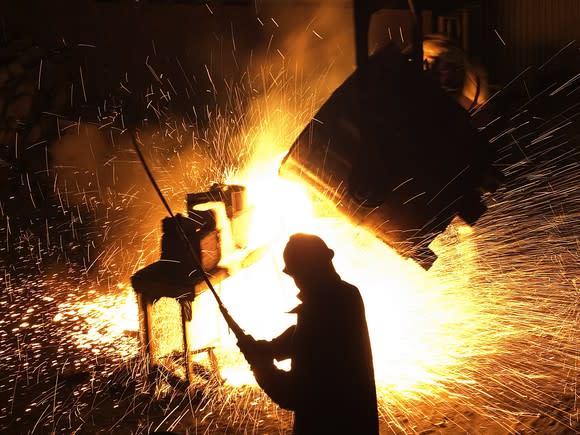3 Stocks That Turned $10,000 Into $1.4 Million
One of the most powerful ways to build wealth is to invest in great companies and then hold them for the long term. And while investing in young, growth-oriented companies looking to disrupt an industry or even creating new ones can pay off with big profits, you don't have to count on high-risk ideas to generate enormous wealth.
Case in point: $10,000 divided equally into Walt Disney Co (NYSE: DIS), Nucor Corporation (NYSE: NUE), and American Express Company (NYSE: AXP) in 1980 would have made you a millionaire, with total returns of more than $1.4 million at last count. That's pretty remarkable for three companies that had already been around for decades at that point.
But that's only part of the story: That original $10,000 investment would generate nearly $25,000 in annual dividends today. That's the amazing wealth-building power of compounding returns. It's also a reminder that the secret to amazing investing returns isn't really a secret. Investing in great companies at reasonable prices and holding them for as long as possible really does work.

Image source: Getty Images.
How the House of Mouse became much, much more
Back in 1980, Disney was already a global brand that had been entertaining people for a half-century. Over the past couple of decades, however, Disney has gone from two theme parks and a movie and animation studio to a global entertainment powerhouse. It now owns major broadcast networks, including ABC and ESPN, as well as film studios Pixar, Marvel, and Lucasfilm. These acquisitions, as well as the expansion of the Disney theme park business around the world, were the key drivers behind 660% earnings-per-share growth and 818% total returns since 1995.

Image source: Disney.
But worries that the acceleration of the cord-cutting trend -- that is, people dropping cable packages -- will hit Disney's profits have caused the stock price to move up and down a lot the past few years. That trend is already hurting the bottom line, with operating income at the media networks segment having peaked in 2015 and declined the past two years.
The steady stream of cable cancelers will continue to affect ESPN, but the media giant has irons in the fire to cut those losses and find a new source of viewer growth. The first is a transition to stand-alone streaming services, which is particularly appealing to sports fans who want to leave cable behind. And with the acquisition of Twenty-First Century Fox's (NASDAQ: FOXA)(NASDAQ: FOX) movie studios and titles and regional sports networks, Disney's rich collection of content -- both sports and popular movie and TV titles -- is about to get even richer.
A $10,000 investment in Disney in 1980 would be worth almost $1.6 million today in total returns. But with the deepest and most valuable collection of entertainment properties in the world on hand and a deep network of popular sporting content that will eventually be offered via stand-alone streaming, Disney's future looks plenty bright.
Still the best steelmaker to own
Nucor has delivered very similar returns to Disney, with a $10,000 investment in that company in 1980 also being worth nearly $1.6 million in total returns to date. But it has delivered in a vastly different industry that is one of the hardest to consistently make a profit at over the long term: steelmaking.

Image source: Getty Images.
The short version of Nucor's success is tied to two important things: flexible operating costs and effective capital allocation. Steelmaking is very capital-intensive, with most steelmakers operating high-volume foundries and steel mills with very high fixed expenses. Steel demand is notoriously cyclical and can fall sharply very quickly. This often leaves many steelmakers caught off guard when volume declines, with too much high-cost capacity it can't just switch off overnight. This can swing the industry from big profits to big losses from one quarter to the next.
Nucor's utilization of "mini mills" since it entered the steelmaking business in the late 1960s is a huge competitive advantage. These mills don't have the high capacity of more traditional mills but are far more flexible. This makes it much easier for Nucor to navigate the cycles of demand without the big losses its competitors often experience when sales fall.
This has given the company's management -- under three excellent CEOs over the past 50 years -- a steady stream of cash to use, often when the market was down and Nucor could acquire assets at bargain prices. This has led to Nucor's becoming America's largest steel producer, as well as its largest recycler. Recycled steel makes up over 75% of the company's feedstock each year.
Since 2010, Nucor has made over a dozen acquisitions, expanding its capacity and capabilities in higher-profit, higher-demand steel segments while many of its competitors have struggled to profit. Nucor remains the best steelmaker in the U.S. and is poised to profit for years to come, even as the steel market goes through its ups and downs.
The payments megatrend is a huge opportunity for AmEx
$10,000 invested in American Express in 1980 hasn't turned out quite as well as Nucor or Disney to date, with total returns of "only" 10,580%. However, it still would have made you a millionaire, with total returns worth just over $1 million at recent prices.

Image source: Getty Images.
American Express is positioned to reward investors very well in the decades to come. Since 1980, much of the company's success has been in the U.S. and other developed nations. But that's very likely to change. In its most recent quarter, the company reported $708.3 billion in billed business in the U.S., versus $376.9 billion outside the U.S. However, international billed business increased 12% last year and now makes up more than one-third of total billed business. This is a major trend that's likely to accelerate.
Within 20 years, 1 billion more people will live in urban settings. The global middle class is growing quickly, and technology is driving a shift toward electronic payments. American Express is likely to be one of the big winners from this trend. It may not turn $10,000 into $1 million over the next few decades, but it has a lot of things in its favor to make it an incredible investment nonetheless.
More From The Motley Fool
Jason Hall owns shares of American Express, Nucor, and Walt Disney. The Motley Fool owns shares of and recommends Walt Disney. The Motley Fool recommends American Express and Nucor. The Motley Fool has a disclosure policy.

 Yahoo Finance
Yahoo Finance 